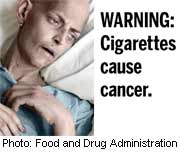
MONDAY, Nov. 22 (HealthDay News) — Earlier this month, the U.S. Food and Drug Administration proposed graphic new warning labels on cigarette packaging, to help curb smoking. But do these often gruesome images work to help smokers quit?
A new study suggests they do. Smokers shown grim images of a mouth with a swollen, blackened and generally horrifying cancerous growth covering much of the lip were more likely to say they wanted to quit than smokers shown less disturbing images.
Researchers had 500 smokers from the United States and Canada view a cigarette package with no image; a package with an image of a mouth with white, straight teeth; one with an image of a moderately damaged smoker’s mouth; and a disfigured mouth with the stomach-turning mouth cancer.
Though researchers did not measure who actually quit, “intention to quit” is an important step in the process — and the more gruesome the image, the more smokers said they wanted to finally kick the habit, according to the study.
“The more graphic, the more gruesome the image, the more fear-evoking those pictures were,” said Jeremy Kees, an assistant professor of marketing at Villanova University. “As you increase the level of fear, intentions to quit for smokers increase.”
The study is published in the fall issue of the Journal of Public Policy & Marketing.
The findings come at a time when the FDA is grappling with what sorts of images tobacco companies should be required to put on cigarette packaging, beginning in 2012.
As part of the Family Smoking Prevention and Tobacco Control Act, passed in 2009, the FDA was granted broad new powers to regulate the manufacturing, advertising and promotion of tobacco products to protect public health.
On Nov. 10, the FDA released a series of images and text that are being considered. The images included a portrait of an emaciated lung cancer patient, cartoon drawings of a mother blowing smoke in an infant’s face and a picture of a woman blowing a bubble, perhaps the implication being she couldn’t blow a bubble with emphysema.
The FDA will chose the images by July 2011. The images will have to cover 50 percent of the front and rear of cigarette packs, and tobacco companies will have until Oct. 22, 2012 to put the images on packaging.
Although a step in the right direction, Kees said the proposed images may not be frightening enough to have much of an impact. None of the proposed images offered up by the FDA are as gruesome as those commonly used in other nations.
“Other countries have had success in using graphic visual warnings on cigarette packages,” Kees said. “It’s important that we don’t get it wrong. If we have even one warning that is cartoonish, that leaves the door open to smokers discounting all warnings as not realistic.”
Evoking fear via images is a tried-and-true method used by public health officials to frighten people into not doing some behavior, whether it’s drugs or unprotected sex, said Michael Mackert, an assistant professor of advertising at University of Texas at Austin.
When he showed the FDA images to his college students, a few, including a picture of an old man grimacing because of a heart attack or stroke, evoked chuckles. Even much harsher images may not have much of an impact among certain groups, particularly young people, he said.
“Teens and younger people, if they have this air of invincibility, are they going to react to the fear appeal?” Mackert said. “A 15-year-old might think, ‘Oh, that’s so far away.’ A lot of college students consider themselves social smokers, who smoke a few cigarettes when they’re at a bar. They think, ‘I don’t smoke enough for that to happen to me,’ or ‘I’ll quit before that happens to me.'”
About 21 percent of the U.S. population smokes daily, according to the U.S. Centers for Disease Control and Prevention.
More information
The U.S. Food and Drug Administration has more about the proposed cigarette packaging.

